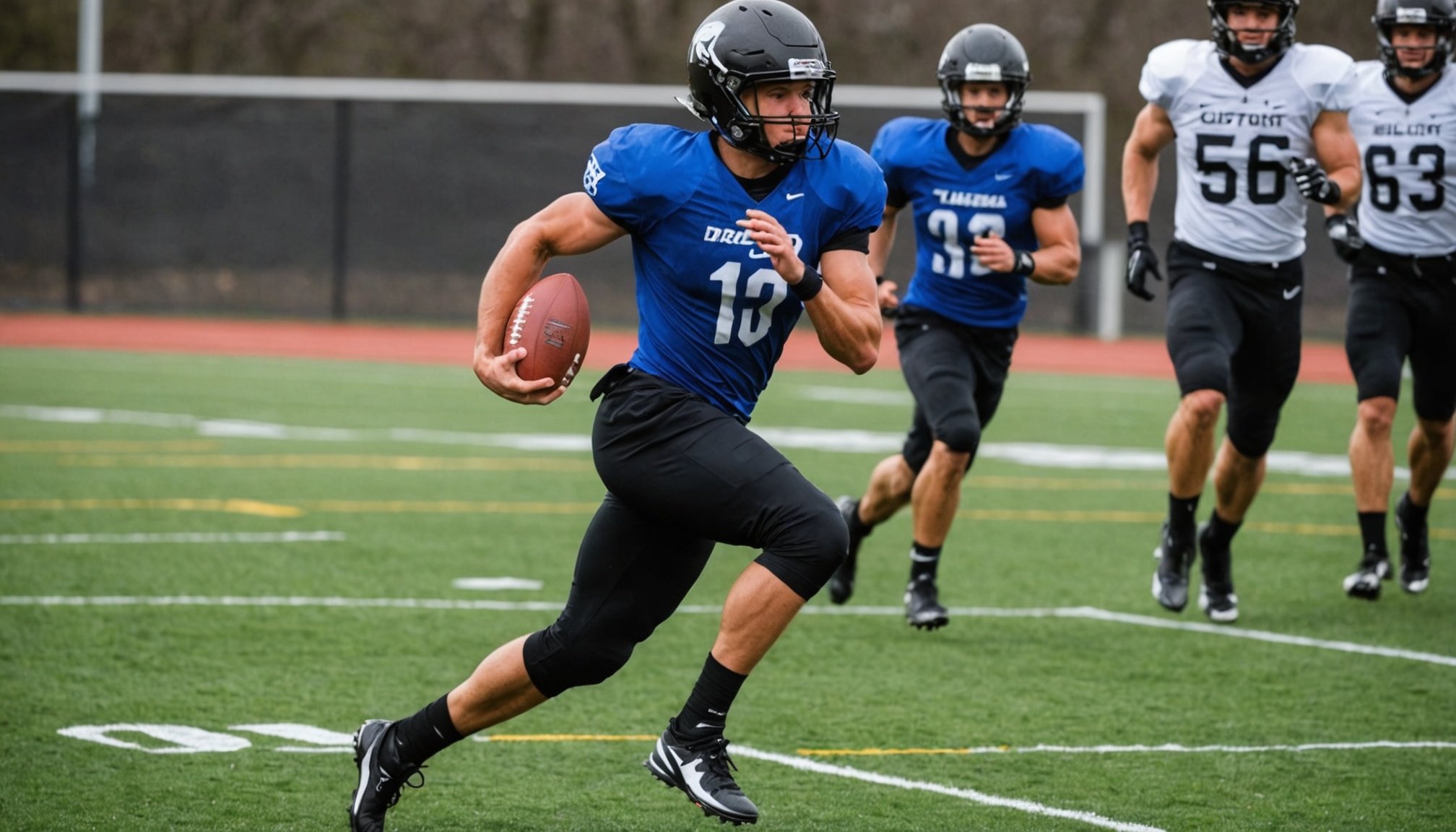Importance of Speed and Agility in Football
Speed and agility are crucial components in enhancing athletic performance on the football field. These skills dictate how a player maneuvers and reacts during a game. In football, the role of speed is pivotal; it determines how quickly a player can move across the pitch, influencing their ability to reach the ball, avoid opponents, and create scoring opportunities. Likewise, agility’s impact is profound, as it allows players to swiftly change directions with balance and control, essential for dodging defenders and maintaining possession.
The combination of speed and agility levels the playing field, enabling players to perform effectively regardless of size or weight. Athletic performance is significantly improved by integrating speed and agility training, which enhances player effectiveness and strategy execution. In-game outcomes are heavily influenced by these attributes, as quick and agile players can often outmaneuver their counterparts, leading to pivotal plays and potential victories.
Also read : Boosting Football Player Performance: The Impact of Wearable Technology
From a physiological perspective, speed and agility training offer numerous benefits. They improve cardiovascular health, increase muscle strength, and boost overall endurance. This specialized training not only elevates a player’s game performance but also contributes to their long-term health and career sustainability.
Key Workouts to Enhance Speed
Enhancing speed requires a combination of sprint drills, strategic speed workouts, and anaerobic training. Each of these elements plays a critical role in improving your overall athletic performance.
This might interest you : Maximizing Fan Connection: Innovative Social Media Strategies for Football Teams in the Off-Season
Sprinting Techniques
Proper sprinting techniques are the bedrock of any speed improvement program. Emphasizing the importance of sprint mechanics, athletes should focus on maintaining a forward lean, driving the knees high, and actively engaging the arms to ensure efficient movement. Practising these techniques enhances the effectiveness of sprint drills and can lead to significant gains in speed.
Cone Drills
Cone drills serve as a fundamental element in agility training. To set up cone drills:
- Place cones in various formations (e.g., zig-zag, T-drill).
- Perform quick and controlled movements around the cones.
Cone drills challenge agility and increase reaction times, seamlessly integrating with anaerobic training regimes.
Resistance Training
Resistance training contributes significantly to speed enhancement. Incorporating resistance exercises like squats, lunges, and leg presses builds muscle strength, crucial for powering faster sprints. Moreover, pairing resistance training with sprint workouts can yield remarkable improvements in anaerobic capacity and overall speed performance.
Effective Agility Drills for Football Players
In the world of football, Agility Drills are a cornerstone in enhancing a player’s performance. These drills not only help in improving footwork but also are crucial for mastering the art of change of direction quickly on the field.
Ladder Drills
Ladder drills are highly effective for increasing footwork speed and precision. To execute them correctly, place an agility ladder on a flat surface. The player runs through it, placing one foot in each square. Variations, such as lateral or crossover steps, significantly enhance coordination.
Shuttle Runs
To set up shuttle runs, mark two points about 10 yards apart. The player sprints to one point, touches the ground, and returns to the start, repeating multiple times. These runs train athletes to make rapid change of direction while maintaining speed, vital for quick on-field maneuvers.
Box Jumps
Box jumps focus on increasing explosive power and agility. Use a sturdy box or platform. Begin by standing still, then jump onto the box, landing with both feet. Variations include lateral box jumps to improve lateral movement, essential for dodging opponents effectively.
By integrating these drills, players sharpen the essential qualities needed in football, making them more competitive and adaptable on the pitch.
Structuring Your Training Program
Creating a well-balanced training program is essential for achieving peak performance and maintaining optimum health. Integral components include periodization, workout frequency, and ensuring adequate rest.
Periodization is a strategic approach, dividing your training program into phases. Each phase focuses on specific goals such as building strength, endurance, or speed. This method helps in avoiding plateaus and keeps athletes motivated and progressing towards peak performance.
Workout frequency varies based on your goals and experience level. For most individuals, it is recommended to engage in exercise routines three to five times per week. These should be of moderate to high intensity levels, varying between 30 to 60 minutes per session. This recommendation aims to strike a balance between intensity and recovery, following guidelines for most effective results.
Rest is equally essential in any training program. Integrating rest days allows muscles to recover and adapt, reducing the risk of injury and burnout. Recovery enhances performance by allowing the body to repair tissues and replenish energy reserves.
In summary, a structured training program with thoughtful planning of workout frequency and rest days contributes significantly to overall health and athletic success.
Understanding the Science Behind Speed and Agility
Speed and agility are deeply rooted in physiology, particularly the role of different muscle fibers. Type II (fast-twitch) muscle fibers are primarily engaged during speed training. These fibers are responsible for quick, explosive movements as they contract rapidly and forcefully. However, they fatigue more quickly than Type I (slow-twitch) fibers, which are more endurance-oriented and essential for sustained efforts.
The nervous system also plays a crucial role in agility and reaction time. Agility involves the body’s ability to change direction quickly and efficiently. This efficiency is achieved through the nervous system’s capacity to process stimuli rapidly and coordinate muscle actions. Enhancing reaction time and decision-making skills is vital for agility improvements.
Integrating neuromuscular training into workouts can significantly enhance speed and agility. This type of training focuses on improving the communication between the nervous system and muscle fibers. Effective neuromuscular training might involve plyometric exercises, balance work, and agility drills. By honing these skills, athletes can improve their overall performance on the field or court. The link between neuromuscular training and enhanced performance underscores its importance in athletic conditioning.
Success Stories and Testimonials
Gaining insights from athlete experiences, particularly in football, can be incredibly motivating for both coaches and players. A growing number of football players have shared their personal success stories, detailing how targeted training has significantly improved their on-field performance. These athletes often report enhanced speed and agility, attributing these improvements to focused, skill-specific training regimens developed by their coaches.
For instance, one professional player recounted a dramatic increase in speed thanks to a customised training protocol. This allowed him to not only achieve personal bests but also sharpen his competitive edge during matches. Such case studies serve as powerful tools in illustrating the potential benefits of specialised training techniques.
Equally important is the testimonial collection process, which involves gathering firsthand accounts of player developments. Conducting thorough and candid testimonial interviews provides invaluable feedback for coaches, allowing them to refine their methodologies and inspire upcoming players. Significantly, testimonials also serve as a robust motivational resource, demonstrating real-world applications and outcomes of training strategies and encouraging more athletes to engage in targeted practices. By emphasizing these success stories and testimonials, coaches can build trust in their training programs while inspiring continuous athletic growth.
Video Demonstrations and Resources
Incorporating video demonstrations into your workout routine can significantly enhance learning and performance. Engaging with these visual tools allows athletes to observe complex movements, understand techniques, and refine skills effectively. Whether you’re working on strength, agility, or specialised sport-specific drills, seeing exercises performed can provide a clearer understanding than textual descriptions alone.
Of particular benefit are recommended video resources tailored for specific drills. These specialised videos focus on intricate details and nuances of each move, offering step-by-step guidance to ensure you execute them with precision. This visual learning approach supports athletes in breaking down and mastering each component at their own pace, which is especially critical for intricate skills that require timing, coordination, and technique.
Access to training resources further aids in complementing these demonstrations. These materials often include complementary guides that expand on the videos’ content, providing deeper insights and context. From comprehensive training programs to detailed exercise descriptions, a wealth of information is available to support your fitness journey. By incorporating these various resources, athletes can establish a well-rounded, informed, and effective training regime that caters to their unique needs and goals, fostering skill development and performance improvement seamlessly.






